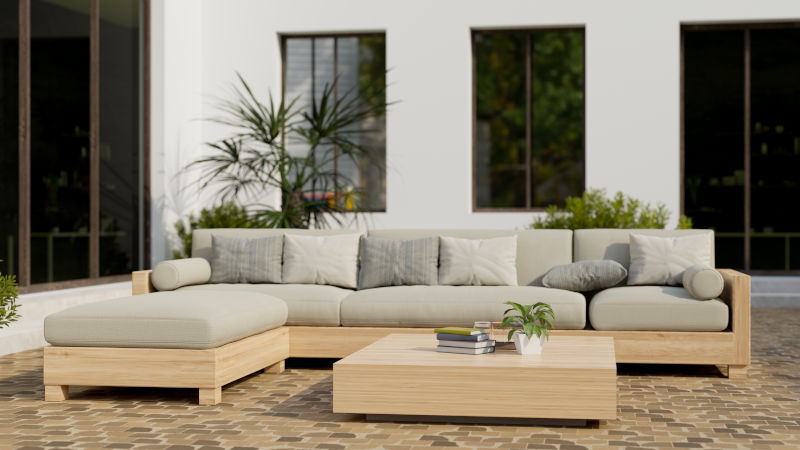Having outdoor furniture where you can relax and breathe in fresh air sounds super, doesn’t it? But every rose has its thorns. Unfortunately, patio furniture is highly susceptible to mildew growth because of moisture in the air. And apart from mildew’s unattractive appearance, it can cause many health issues and allergic reactions like coughing and sneezing.
So what do you do when you notice mildew growing on your precious furniture? We’re about to tell you everything you need to know, including how to clean patio cushions with mildew!
How to Clean Patio Furniture With Mildew
Whether you have plastic, wicker, or wooden furniture, you can clean it from mildew in a few minutes. Here are our guides to leaving your patio furniture all clean and shiny.
Wooden Furniture
If you live in a hot area, you might notice mildew growing on your wooden furniture during summer. To clean it, you can use a mixture of bleach and water or white vinegar. Bleach is more efficient, but it might leave an annoying smell on wood.
Use a spray bottle to apply the cleaner you choose to your furniture, then use a rag to wipe the mildew clean.
Plastic Furniture
You can clean your plastic patio furniture using a mixture of white vinegar and dish soap. Here are the ingredients you’ll need:
- Two cups of vinegar
- One gallon of water, preferably hot
- Two tablespoons of any dish soap you have
Mix the three ingredients in a spray bottle, and sprinkle the mixture on the dirty areas of your furniture. If there are any cracks or grooves, use a scrub brush to clean thoroughly, but rub it softly so that you don’t scratch the plastic. Once the mildew is all clean, rinse the plastic furniture with water and leave it to dry.
Wicker Furniture
Wicker furniture is the most challenging to clean out of the three types because of the weave patterns. If mildew gets through the grooves, you’ll need to give the furniture a deep cleaning session.
First, you should mix some dish soap and water in a bowl. Then, soak a rug in the soap and use it to wipe the furniture clean. You can also use a soft scrub brush if mildew gets deep inside the wicker.
After the mildew is gone, use a water hose to rinse all the chairs and sofas. Then, leave them out in the sun for a few hours to dry.
How to Clean Patio Cushions With Mildew
Mildew can grow on both acrylic and fabric cushions, but luckily, it’s easily cleanable. Here’s what to do to clean the two types.
Fabric Cushions
To leave your fabric cushions all clean, you’ll need the following:
- Scrub brush
- Spray bottle
- One gallon of water
- Half a cup of bleach
Mix the two liquids in the bottle, and spritz it on a hidden area of your cushion.
If the fabric color fades, then it isn’t suitable for bleaching, and you’ll need to use a less aggressive cleaner. You can use a disinfecting detergent, but it’ll take you more time to clean.
But if the color stays the same, spray the mixture all over the dirty cushion. Then, grab the brush and rub the cushion vigorously to remove any sign of mildew. If it’s too stubborn, spray more bleach and rub again. Once the cushion is all clean, give it a quick rinse with water and leave it in the sun for a few hours or till it’s completely dry.
Acrylic Cushions
If your patio furniture has acrylic cushions, you’ll need the following:
- One cup of bleach
- One gallon of water
- Two cups of cleaning detergent
Mix the three liquids in a spray bottle, and do the same spot test we mentioned in the previous step. In general, whenever you use bleach on any material, you should test it first to make sure it doesn’t have an adverse effect.
If the bleach doesn’t affect your cushions, spray the mixture across the dirty areas. Then, leave the cushions for half an hour before wiping them clean using a cloth. Next, give them a quick rinse and leave them in the sun to dry.
Tips and Tricks to Prevent Mildew From Growing on Your Patio Furniture
If you want to prevent the problem before it happens, here’s what to do to keep the mildew at bay:
- Keep the patio furniture indoors when you aren’t using it (during winter or if you travel a lot)
- Apply a waterproof treatment to your furniture
- Make sure your furniture gets sufficient sunlight
- Regularly clean the furniture to remove any mold or mildew before they grow extensively
- If you store your furniture in a closed area for a long time, make sure it’s properly aerated to reduce moisture
What Causes Mildew to Grow on Patio Furniture
The most famous culprit when it comes to mildew growth is humidity. If your furniture gets wet or moist and doesn’t dry for a long time, it’ll make for a perfect environment for mildew to grow.
Suppose the weather is all cloudy and rainy for a few weeks where you live. If you have outdoor furniture, it’ll get wet and won’t get enough sunlight to dry because of the clouds. As a result, mildew and mold might grow. The same will happen if you store your furniture in a humid room for a long time without regular cleaning sessions or proper aeration.
To Wrap Up
Mildew can grow on your patio furniture if it finds the proper conditions, like humidity and lack of sunlight. While cleaning it can be challenging, it’s possible if you use the right ingredients. You can use bleach to clean wooden, fabric, or acrylic furniture. As for plastic and wicker, you can use white vinegar or dish soap.

